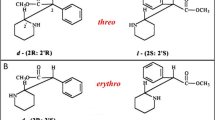Abstract
Rationale
The full D1 receptor agonist dihydrexidine (DHX) [(+/−)-trans-10,11-dihydroxy-5,6,6a,7,8,12b-hexahydrobenzo[a]phenanthridine hydrochloride] is under clinical development (DAR-100) for Parkinson’s disease and schizophrenia. Despite the clinical development of DHX, very little is known about its discriminative stimulus properties in rats. To more fully characterize the discriminative stimulus properties of DHX, we trained rats to discriminate DHX (3 mg/kg, i.p.) from vehicle. Methods: Substitution tests in rats discriminating DHX (3 mg/kg, i.p.) from vehicle were performed with structurally distinct D1 receptor agonists with both partial and full intrinsic efficacy. In addition, the peripherally restricted D1 agonist, fenoldopam, was evaluated.
Results
SKF 75670A, ABT-431, dinapsoline, SKF 81297, and SKF 82958 all fully substituted in a dose-dependent manner. The rank order of potency for substitution was SKF 82958<ABT-431<SKF 75670A≤dinapsoline<SKF 81297<DHX. Fenoldopam (10 and 30 mg/kg) did not substitute and was without effect on rates of responding.
Conclusions
DHX produces prominent dopamine D1 receptor agonist effects in vivo and is likely to produce subjective effects in humans similar to other D1 receptor agonists.



Similar content being viewed by others
References
Anderson PH, Jansen JA (1990) Dopamine receptor agonists: selectivity and dopamine D1 receptor efficacy. Eur J Pharmacol 188:335–347
Arnt J (1988) The discriminative stimulus properties of the D-1 agonist SK&F 38393 and the D-2 agonist (−)-NPA are mediated by separate mechanisms. Life Sci 42(5):565–574
Arnt J, Bogeso KP, Hyttel J, Meier E (1988) Relative D1 and D2 receptor affinities and efficacy determine whether dopamine agonists induce hyperactivity or oral stereotypy in rat. Pharmcol Toxicol 62:121–130
Brewster WK, Nichols DE, Riggs RM, Mottola DM, Lovenberg TW, Lewis MH, Mailman RB (1990) Trans-10,11-dihydroxy-5,6,6a,7,8,12b-hexahydrobeno[a]phenanthridine: a highly potent selective dopamine D1 full agonist. J Med Chem 33:1756–1764
Chausmer AL, Katz JL (2002) Comparison of interactions of D1-like agonists, SKF 81297, SKF 82958 and A-77636, with cocaine: locomotor activity and drug discrimination studies in rodents. Psychopharmacology 159:145–153
Cunningham KA, Callahan PM, Appel JB (1985) Dopamine D1 receptor mediation of the discriminative stimulus properties of SKF 38393. Eur J Pharmacol 119:121–125
Desai RI, Terry P, Katz JL (2003) Comparison of the discriminative-stimulus effects of SKF 38393 with those of other dopamine receptor agonists. Behav Pharmacol 14(3):223–228
Ghosh D, Snyder SE, Watts VJ, Mailman RB, Nichols DE (1996) 9-Dihydroxy-2,3,7,11b-tetrahydro-1H-naph[1,2,3-de]isoquinoline: a potent full dopamine D1 agonist containing a rigid-beta-phenyldopamine pharmacophore. J Med Chem 39:549–555
Gleason SD, Witkin JM (2004) Effects of dopamine D1 receptor full agonists in rats trained to discriminate SKF 38393. Behav Pharmacol 1:85–89
Goudie AJ, Smith JA, Millan MJ (2004) Characterization of the effects of receptor-selective ligands in rats discriminating the novel antipsychotic quetiapine. Psychopharmacology (Berl) 171(2):212–222
Hahn RA, Wardell JR Jr, Sarau HM, Ridley PT (1982) Characterization of the peripheral and central effects of SK&F 82526, a novel dopamine receptor agonist. J Pharmacol Exp Ther 223(2):305–313
Haile CN, Carey G, Varty GB, Coffin VL (2000) The dopamine D(1) receptor agonist SKF-82958 serves as a discriminative stimulus in the rat. Eur J Pharmacol 388:125–131
Izenwasser S, Katz JL (1993) Differential efficacies of dopamine D1 agonists for stimulating adenylyl cycalse in squirrel monkey and rat. Eur J Pharmacol 246:39–44
Kamien JB, Woolverton WL (1985) The D1 dopamine agonist SKF 38393 functions as a discriminative stimulus in rats. Psychopharmacology 87:368–370
Lovenberg TW, Brewster WK, Mottola DM, Lee RC, Riggs RM, Nichols DE, Lewis MH, Mailman RB (1989) Dihydrexidine, a novel selective high potency full dopamine D-1 receptor agonist. Eur J Pharmacol 166(1):111–113
Michaelides MR, Hong Y, DiDomenico S Jr, Bayburt EK, Asin KE, Britton DR, Lin CW, Shiosaki K (1997) Substituted hexahydrobenzo[f]thieno[c]quinolines as dopamine D1-selective agonists: synthesis and biological evaluation in vitro and in vivo. J Med Chem 40:1585–1599
Reavill C, Bond B, Overend P, Hunter AJ (1993) Pharmacological characterization of the discriminative stimulus properties of the dopamine D1 agonist, SKF 81297. Behav Pharmacol 4(2):135–146
Rosenzweig-Lipson S, Bergman J (1993) Dopamine D1 receptor involvement in the discriminative-stimulus effects of SKF 81297 in squirrel monkeys. J Pharmacol Exp Ther 267:765–775
Roth BL, Kroeze Wk, Patel S, Lopez E (2000) The multiplicity of serotonin receptors: uselessly diverse molecules or an embarrassment of riches? Neurosci 6:252–262
Schechter MD (1995) The discriminative properties of the D1 dopamine agonist dihydrexidine in the rat. Psychopharmacology 119:79–84
Schuster CR, Johanson CE (1988) Relationship between the discriminative stimulus properties and subjective effects of drugs. In: Colpaert FC, Balster RL (eds) Psychopharmacology, series 4: transduction mechanisms of drug stimuli. Springer, Berlin Heidelberg New York, pp 161–175
Williams JE, Woolverton WL (1990) The D2 agonist quinpirole potentiates the discriminative stimulus effects of the D1 agonist SKF 38393. Pharmacol Biochem Behav 37(2):289–293
Williams JE, Sutherland JV, Woolverton WL (1990) Evaluation of the interaction between D1 and D2 receptors in a drug discrimination paradigm. Behav Neural Biol 53(3):378–392
Witkin JM, Nichols DE, Terry P, Katz JL (1991) Behavioral effects of selective dopaminergic compounds in rats discriminating cocaine injections. J Pharmacol Exp Ther 257(2):706–713
Woolverton WL, Kamien JB, Goldberg LI (1985) Effects of selective dopamine receptor agonists in rats trained to discriminate apomorphine from saline. Pharmacol Biochem Behav 22(4):577–581
Acknowledgement
We thank Dr. Charles Yang for inspiration and helpful discussions.
Author information
Authors and Affiliations
Corresponding author
Rights and permissions
About this article
Cite this article
Gleason, S.D., Witkin, J.M. Effects of dopamine D1 receptor agonists in rats trained to discriminate dihydrexidine. Psychopharmacology 186, 25–31 (2006). https://doi.org/10.1007/s00213-006-0342-2
Received:
Accepted:
Published:
Issue Date:
DOI: https://doi.org/10.1007/s00213-006-0342-2




